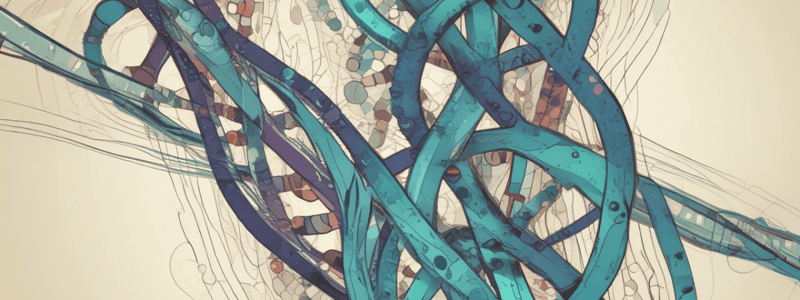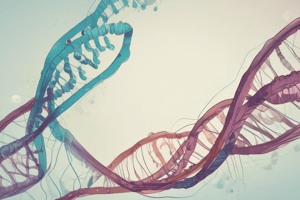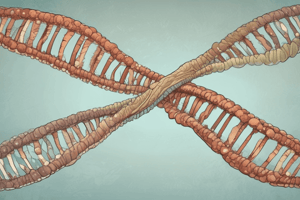Podcast
Questions and Answers
What does the term synteny refer to?
What does the term synteny refer to?
- Genes that are not physically linked
- Genes that are far apart on the same chromosome
- Genes located on different chromosomes
- Two or more genes located on the same chromosome (correct)
What is the result of crossing over during meiosis?
What is the result of crossing over during meiosis?
- Linked genes segregate independently
- Only maternal chromosomes are involved
- Recombinant genotypes are produced (correct)
- All alleles are lost
Why do genes close to one another on the same chromosome not follow Mendel's law of independent assortment?
Why do genes close to one another on the same chromosome not follow Mendel's law of independent assortment?
- Because they are far apart on the same chromosome
- Because they are not genetically linked
- Because they are located on different chromosomes
- Because they are physically linked and tend to be transmitted as a unit (correct)
What is the purpose of a two-factor cross?
What is the purpose of a two-factor cross?
In Morgan's three-factor cross, what did he observe about the combinations of traits?
In Morgan's three-factor cross, what did he observe about the combinations of traits?
What is the result of crossing over between genes that are far apart on the same chromosome?
What is the result of crossing over between genes that are far apart on the same chromosome?
What is the term for the process by which genes on the same chromosome are transmitted together?
What is the term for the process by which genes on the same chromosome are transmitted together?
What is the purpose of a dihybrid cross?
What is the purpose of a dihybrid cross?
What did Bateson and Punnett observe in their dihybrid cross experiment?
What did Bateson and Punnett observe in their dihybrid cross experiment?
What is the number of linkage groups in humans?
What is the number of linkage groups in humans?
What is the result of crossing over on the frequency of recombinant offspring?
What is the result of crossing over on the frequency of recombinant offspring?
What is the result of genetic linkage on inheritance patterns?
What is the result of genetic linkage on inheritance patterns?
What is the term for the exchange of DNA between two homologous chromosomes during meiosis?
What is the term for the exchange of DNA between two homologous chromosomes during meiosis?
Why did Bateson and Punnett's experiment not yield the expected 9:3:3:1 phenotypic ratio?
Why did Bateson and Punnett's experiment not yield the expected 9:3:3:1 phenotypic ratio?
What is the term for the probability of observing a certain combination of traits?
What is the term for the probability of observing a certain combination of traits?
What is the term for the offspring that have a combination of alleles not found in the original parents?
What is the term for the offspring that have a combination of alleles not found in the original parents?
What is the primary purpose of performing a chi square analysis in the context of a dihybrid cross?
What is the primary purpose of performing a chi square analysis in the context of a dihybrid cross?
Why is it important to propose a hypothesis of independent assortment in a chi square analysis?
Why is it important to propose a hypothesis of independent assortment in a chi square analysis?
What is the primary difference between genetic linkage and independent assortment?
What is the primary difference between genetic linkage and independent assortment?
What is the goal of rejecting the null hypothesis in a chi square analysis?
What is the goal of rejecting the null hypothesis in a chi square analysis?
What type of cross is being analyzed in a chi square analysis?
What type of cross is being analyzed in a chi square analysis?
What is the purpose of calculating expected values in a chi square analysis?
What is the purpose of calculating expected values in a chi square analysis?
Flashcards are hidden until you start studying
Study Notes
Introduction to Linkage
- Each species has thousands to tens of thousands of genes, but only a few dozen chromosomes, which means each chromosome carries many hundred or even thousands of different genes.
- The transmission of genes close to one another on the same chromosome violates Mendel's law of independent assortment.
Synteny and Genetic Linkage
- Synteny refers to two or more genes located on the same chromosome and being physically linked.
- Genetic Linkage is the phenomenon where genes close together on a chromosome tend to be transmitted as a unit, influencing inheritance patterns.
- Chromosomes are called linkage groups, containing a group of linked genes.
- The number of linkage groups is equivalent to the number of types of chromosomes in the species.
Bateson and Punnett's Experiment
- Bateson and Punnett conducted a two-factor cross involving flower color and pollen shape, which did not yield the expected 9:3:3:1 phenotypic ratio.
- The results indicated that the genes were not assorted independently, but rather were linked on the same chromosome.
Crossing Over and Linkage
- Linkage is altered during meiosis due to crossing over, which occurs during Prophase I.
- Crossing over involves the exchange of DNA segments between non-sister chromatids of homologous chromosomes.
- Recombinant offspring are produced through crossing over, resulting in novel combinations of genetic material.
Morgan's Experiments
- Thomas Hunt Morgan provided the first direct evidence of linkage through studies on X-linked traits in Drosophila.
- Morgan's three-factor cross involving body color, eye color, and wing length showed a significant number of non-parental combinations, indicating linkage.
- Morgan concluded that the genes were located on the X chromosome and tend to be transmitted together as a unit.
Chi Square Analysis
- Chi Square Analysis is a statistical method used to determine if the outcome of a dihybrid cross is consistent with linkage or independent assortment.
- The method involves proposing a hypothesis of independent assortment and calculating expected values.
- The analysis allows for the rejection of the hypothesis of independent assortment in favor of a linkage hypothesis.
Studying That Suits You
Use AI to generate personalized quizzes and flashcards to suit your learning preferences.




